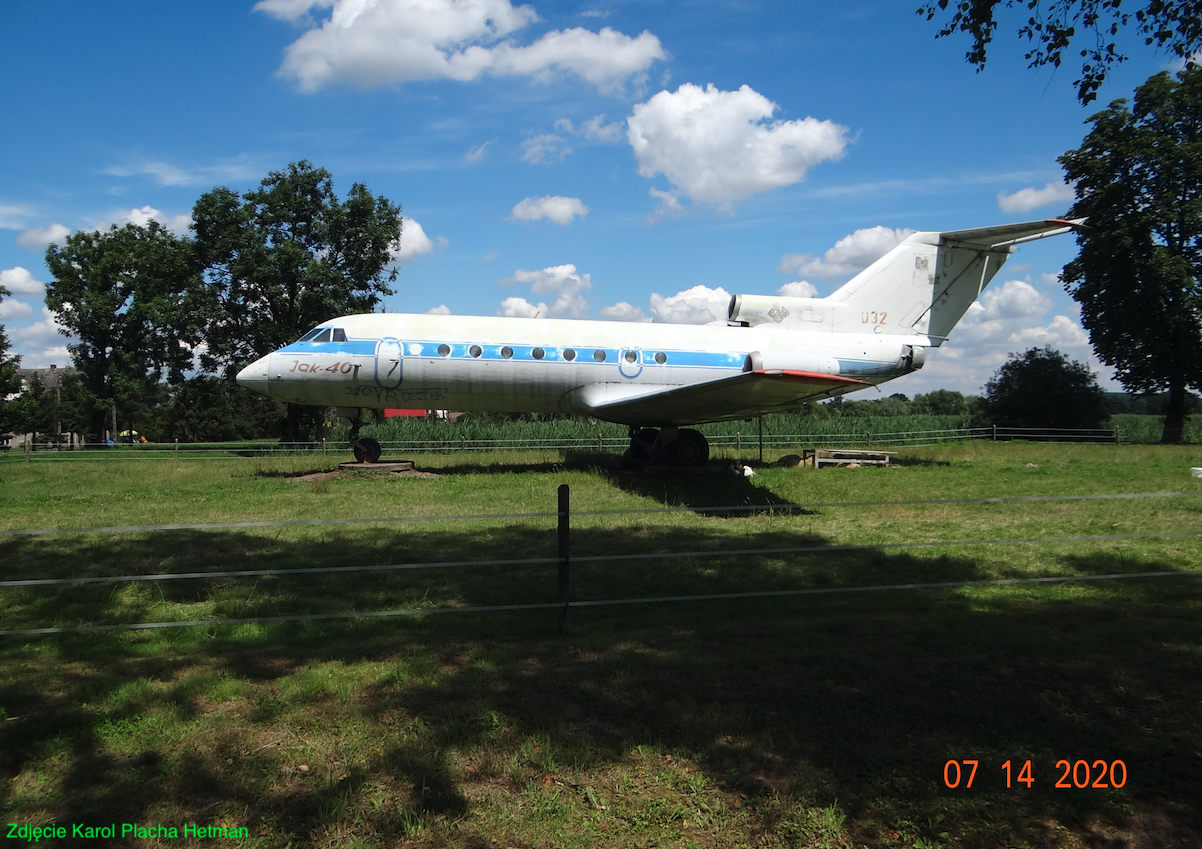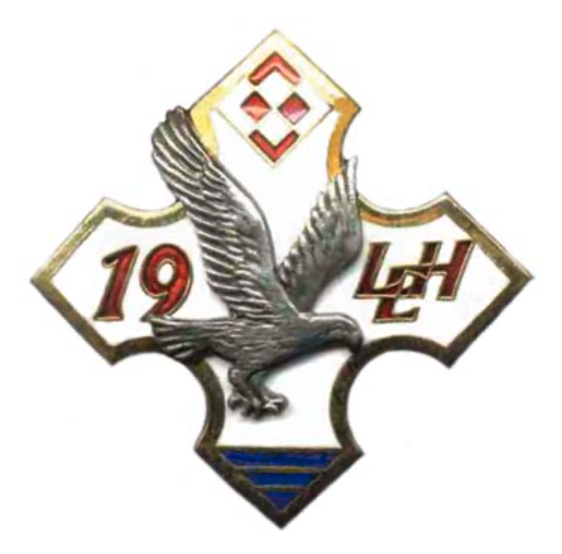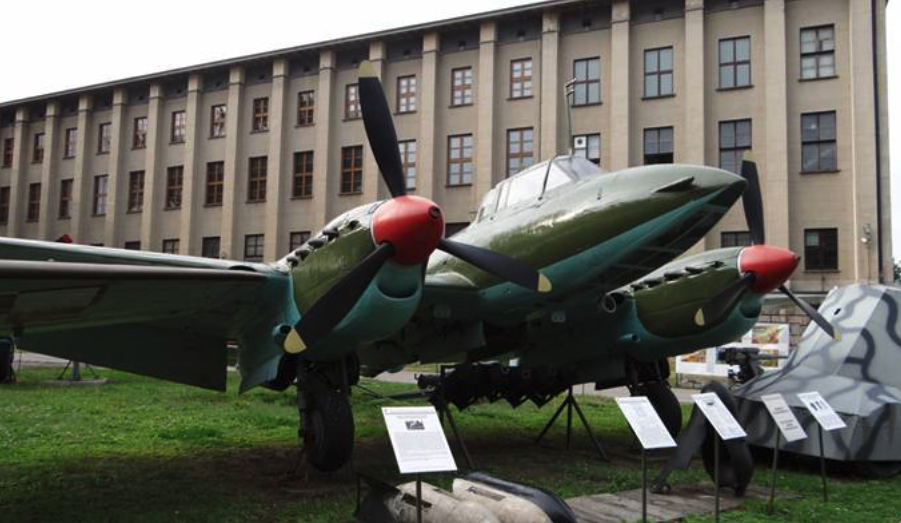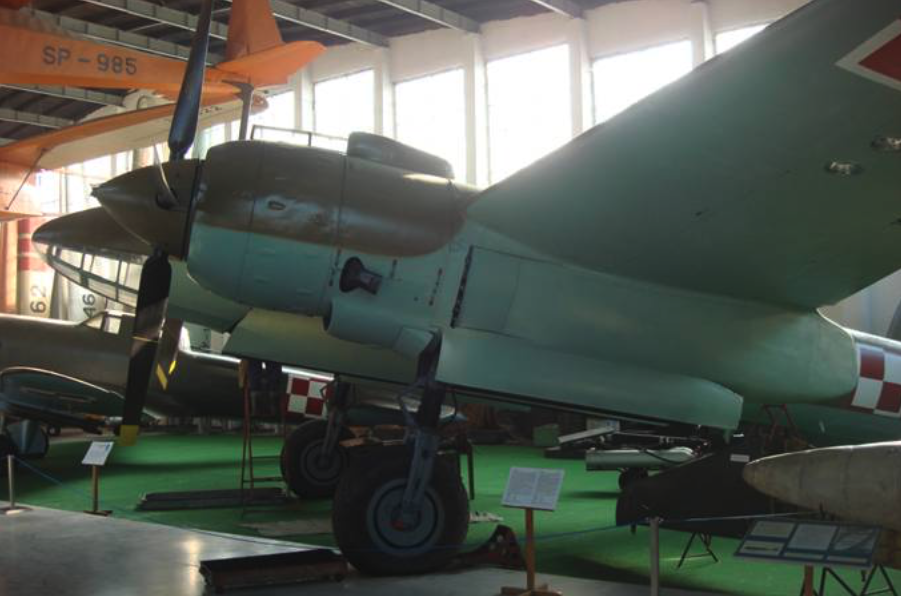Kraków 2014-03-25
19th Aviation Towing Squadron in Słupsk.
August 1, 1954 – March 31, 1999.
History
Photo description: The Yakovlev Jak-40 nb 032 aircraft was operated in the 19th Air Towage Squadron in Słupsk.
The first half of the 1950s was a period of rapid increase in the number of new, modern fighter aircraft produced in Polish factories. This large amount of modern equipment forced an increase in the number of flying personnel, and thus the development of education for future aces of the sky. Following this line of thought, we come to the issue of practical training. No training, even the current training on modern simulators, can replace live shooting exercises. It’s about shooting at air targets, especially towed ones. This type of training was considered the most logical and relatively cheap.
In the Polish People’s Republic, the first plane used to tow air targets was the twin-engine Pe-2 FT. However, these planes were very unreliable and difficult to fly. Nevertheless, a key of these machines was organized. In 1952, Pe-2 FT aircraft were withdrawn. (The last flights of Pe-2 FT aircraft were made in Bydgoszcz in 1954). Instead of Pe-2 FT aircraft, Tu-2 aircraft began to be used (more safe to fly than Pe-2 FT). Tu-2 planes were organized into one towing unit, and Świdwin Airport was chosen as the stationing site. Klucz had 3 Tu-2 and 4 Po-2 planes in stock. The latter planes were used as liaison planes. The location of the Key at the Świdwin Airport was very deliberate, because it was close to land and sea training grounds.
In 1954, the Air Force Command became convinced that the organizational system used was no longer sufficient. The number of tasks increased and it was necessary to increase the number of aircraft. Therefore, in August 1954, on the basis of the existing Key, a Squadron was organized and designated as the 19th Air Towing Squadron. The new organization allowed for individual management of the unit and performance of tasks for other combat Regiments.
The 19th Squadron accepted the entire number of personnel and equipment of the dissolved Squadron. Squadron No. 6/208 was assigned to 105 soldiers and 1 contract employee. Tu-2 and Po-2 aircraft were adopted. According to the squadron’s status, there could be 12-14 aircraft. Therefore, the range of tasks assigned to the Squadron was expanded. Tasks were performed for anti-aircraft artillery and fighter aviation. Air and surface firing were also secured for the Polish Navy. In addition to typical towing tasks, the second task was broadly understood transport. The number of Po-2 and CSS-13 aircraft, which were Polish, modernized equivalents of the Soviet Po-2, was increased. The Squadron received Li-2 transport aircraft, probably 2 machines. But none of these machines was suitable for heavy-duty shooting tasks for fighter aircraft, so Lim-2 fighters equipped with a special hitch for towing targets appeared in stock. Initially, there were two such planes in stock. The 19th Squadron became operational on October 21, 1954, although it also performed towing duties throughout the year.
1955 year.
Lim-2 planes were well suited to the tasks performed by the Squadron, so the unit was equipped with more machines of this type. Additionally, in the fall of 1955, the last Tu-2 bomber planes were transferred from the 15th Independent Reconnaissance Aviation Squadron of the Polish Navy to the 19th Squadron. The Polish Aviation Command wanted to gather the unpromising Tu-2 bombers in one unit so that they could complete their service here.
1956-1959 year.
In 1956, it was decided to relocate the 19th Squadron from the Świdwin Airport to the Słupsk-Redzikowo Airport. Słupsk JW. 2571. One of the reasons was the shorter distance from the Ustka Marine Training Ground. The facilities were also better here. The number of tasks increased and the towing and liaison unit became a towing and transport unit. Light Yak-12 aircraft appeared in stock. They performed observation and liaison tasks. In 1957, Il-12 transport aircraft were also introduced, and a little later their modernized Il-14 type. From January 2, 1957, the Il-12 aircraft towed the artillery firing tube.
1960-1969 year.
The period of 1960-1962 was a time of further reorganizations in the Polish Military Aviation. In 1960, organizationally, the 19th LEH (Air Tow Squadron) was subordinated to the 2nd Air Defense Corps OK. This corps had four Fighter Regiments under its command; 11. PLM Debrzno, 25. PLM Pruszcz Gdański, 26. PLM Zegrze Pomorskie and 28. PLM Słupsk. Additionally; 43rd Liaison Aviation Squadron – Bydgoszcz, 129th Air Defense Artillery Regiment – Szczecin, 136th Air Defense Artillery Regiment – Bydgoszcz, 2nd Radio Technical Battalion – Grudziądz, 8th Radio Technical Battalion – Słupsk, 9th Radio Technical Battalion – Choszczno.
Since the 19th LEH was also operationally subordinated to the Navy, it was often mentioned in its operational orders. For this reason, the aircraft of the 19th LEH were frequent visitors to Navy airports, especially Siemirowice and Babie Doły Airports. What is most interesting is that the 19th LEH, until its disbandment on March 31, 1999, was constantly subordinated to the 2nd Corps commanded in Bydgoszcz and was constantly in the squadron’s position.
Analyzing the operational capabilities of the Il-28 bombers, the Air Force Command came to the conclusion that these planes should be used to provide heavy-duty fire protection. In 1962, training of crews on Il-28 aircraft began for the needs of the 19th Aviation Towing Squadron. In this way, another type of aircraft was equipped with the 19th LEH, also in the UIł-28 training version. The 19th LEH was the last Polish unit to receive Il-28 aircraft. These were machines transferred from other Polish units. Already in August 1962, Il-28 aircraft from the 19th LEH took part in bilateral Polish-CCCP naval fleet exercises.
The reader deserves an explanation at this point. In the period 1955–1988, the 15th Independent Reconnaissance Aviation Squadron – Siemirowice Airport operated in the Navy. The basic aircraft of this Squadron were the SB Lim-2 and Il-28 aircraft.
In the 1960s, Polish TS-8 training aircraft appeared in the Squadron’s inventory, replacing the archaic Po-2 and uneconomical Yak-12 aircraft. In turn, Lim-2 aircraft were supplemented with SB Lim-1, SB Lim-2, Lim-5 fighters.
1970-1979 year.
In 1973, Il-28 and Li-2 aircraft were withdrawn from service of the 19th LEH. The remaining Il-28 and UIł-28 aircraft were gathered in the 15th ELR (SELR) in Siemirowice. On December 29, 1977, the combat operation of Il-28 aircraft in the Polish Air Force officially ended. The training ended on August 27, 1978. On December 23, 1978, the operation of Il-28 aircraft in the Naval Aviation ended, specifically in the 15th ELR (SELR) in Siemirowice. On October 2, 1979, the last flights of Il-28 naval pilots in Poland took place, specifically the 19th LEH in Słupsk. Officially, the last flight was a flight to the training ground in Nadarzyce, by the crew; captain pil. W. Woźniak, captain navigation I. Klepacki, x-ray shooter. Senior Petty Officer H. Matacz.
On October 3, 1979, several planes from Słupsk (at least 4) flew to Nadarzyce, where they served as ground targets on the training ground and these were the last Il-28 flights in Poland. In the following months, the remaining operational Il-28s were distributed to airports throughout Poland for use as targets on training grounds or as exhibits for museums and military collections. They were transported by road. Unfortunately, despite the demand, this aircraft, good for its age, did not have a successor.
1980 year.
In 1980, the 19th Squadron received Yak-40 aircraft. These were not new machines, but transferred from the 36th SPLT. There were probably 4 machines. Among them was definitely the Yak-40 nb 032 plane.
Jak-40 nb 032 No. 9331129, was built on August 6, 1973, and delivered to Poland on August 12, 1973. The aircraft was accepted by the 36th SPLT Unit. 2139 (then the 36th Special Aviation Regiment. The name was changed on April 1, 1974). On July 25, 1980, the aircraft was transferred to the 19th LEH. After disbanding the 19th LEH, the aircraft returned to the 36th SPLT. After the end of its operation, it fell into private hands and was built in Brzeźnica near Skawina.
Jak-40 aircraft were used to transport VIPs from Warsaw to Nadarzyce or to the Ustka Naval Training Area during the exercises.
1982 year.
In 1982, the 19th Squadron was part of the 2nd Air Defense Corps with headquarters in Bydgoszcz. The Corps had the following units:
43rd Liaison and Transport Aviation Squadron: basing location – Bydgoszcz, aircraft: 3 PZL-104 Wilga, 2 An-2, helicopters: 5 Mi-2;
19th Aviation Towing Squadron: basing location – Słupsk, aircraft: 4 TS-11, 4 Jak-40, 2 SB Lim-2, 2 Lim-5;
2nd Fighter Aviation Regiment "Kraków": base – Goleniów, aircraft: 24 MiG-21 M/MF, 5 MiG-21 UM;
9th Fighter Aviation Regiment: base – Zegrze Pomorskie, aircraft: 26 MiG-21 bis, 6 MiG-21 UM;
28th Fighter Aviation Regiment: base – Słupsk-Redzikowo, aircraft: 31 MiG-23 MF, 6 MiG-23 UM;
41st Fighter Aviation Regiment: base – Malbork, aircraft: 24 MiG-21 MF, 6 MiG-21 UM;
The above table shows that the 19th Squadron accepted TS-11 aircraft and no longer had PZL Lim-2 aircraft in stock.
1990 year.
On March 31, 1999, the 19th Aviation Tow Squadron was disbanded. It is worth quoting the response of the Minister of National Defense, Janusz Onyszkiewicz, to a parliamentary question in the Sejm of the Republic of Poland on this matter:
In response to Mr. Jan Sieńka’s question regarding the functioning of the 19th Aviation Towing Squadron in Słupsk (578), I kindly ask you to accept the following explanations. In accordance with the "Program for Integration with the North Atlantic Treaty Organization and Modernization of the Polish Armed Forces for 1998-2012" adopted last year by the Council of Ministers, significant and necessary structural changes are being implemented in the Polish Army, constituting one of the elements of the reconstruction of the state’s defense system. On the basis of the above document, the "Plan of Organizational and Distribution Intentions of the Polish Armed Forces for 1999-2000" was developed, according to which, among others: On March 31, 1999, the 19th Aviation Towing Squadron stationed in Słupsk was disbanded. In addition, it was planned to create the 2nd Aviation Squadron of Liaison and Transport in Bydgoszcz as a result of the merger of the disbanded 19th Aviation Tow Squadron with the 2nd Aviation Squadron in Bydgoszcz. Moreover, it should be noted that when making the decision to liquidate the 19th Aviation Squadron in Słupsk, economic considerations were also taken into account. It would be unjustified to maintain the entire squadron’s personnel to protect only two Yak-40 aircraft, used only periodically for the Ustka training ground. I would like to assure you that the disbandment of the 19th Aviation Towage Squadron and the 28th Fighter Aviation Regiment will not affect the level of security in the region. Moreover, the military airport in Słupsk will not be closed down, as it is intended as an alternate airport for the Air Base in Zegrze Pomorskie. By providing the above explanations, I hope that you will find them sufficient.
Minister of National Defense Janusz Onyszkiewicz, Warsaw, May 14, 1999.
Commanders of the 19th Aviation Towing Squadron;
lieutenant pil. Marian NiewczasMajor Pil. Ryszard ZismandarskiMajor Pil. Zdzisław Strejlau (1959 – 1962)Lt. Col. Pil. Wojciech Stasiak (1962 – 1978)Lt. Col. Pil. Piotr Zatwarnicki (1979 – 1987)Major Pil. Henryk Gojlik (1987 – 1994)captain pil. Piotr Łukaszewicz (1996 – 1999)
Written by Karol Placha Hetman




